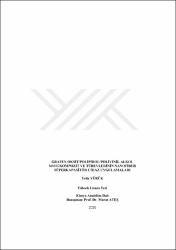| dc.contributor.advisor | Ateş, Murat | |
| dc.contributor.author | Yürük, Yeliz | |
| dc.date.accessioned | 2022-04-06T06:49:34Z | |
| dc.date.available | 2022-04-06T06:49:34Z | |
| dc.date.issued | 2020 | |
| dc.identifier.uri | https://tez.yok.gov.tr/UlusalTezMerkezi/TezGoster?key=wf-FPgY-5qjHEzEoOgvMsyOZ6nFQDaqo7FiqW1Mz3UvtAQl1FvYU-MMRM33oKGKN | |
| dc.identifier.uri | https://hdl.handle.net/20.500.11776/4184 | |
| dc.description.abstract | Bu çalışmada süperkapasitörler için elektrot malzemesi olarak geniş yüzey alanlarına ve yüksek spesifik kapasitans değerlerine ulaşılmak amacıyla nanolif yapıların kullanılması tercih edilmiştir. Elektrot materyali olarak kullanılacak olan bu kompozit nanolifleri üretmek için en etkin yöntem olan elektrospin yöntemi tercih edilmiştir. Bu yöntemde, hazırlanan polimer kompozit şırınganın içine yerleştirilir ve şırınga ucuna 25 kV'a kadar gerilim uygulanır. Besleyici ünitedeki şırınganın ucunda duran polimer damlası kritik bir voltaj değerine kadar küresel bir biçimde bulunur. Uygulanan potansiyel fark bir eşik değerine ulaştığı anda ise polimer damlası koni biçimini alır ve voltajdaki çok küçük bir artışla birlikte koni ucundan bir jet fışkırır. Bu jette besleme ünitesine belli bir mesafe uzağına yerleştirilen toplayıcı levhaya doğru farklı yollar izleyerek ilerler ve nanofiber yapıları oluşturulmuştur. Bu yöntemde kullanılan GO, rGO, PPy, GO/PPy/KS, rGO/PPy/KS, GO/PPy/PVA, rGO/PPy/PVA, GO/PPy/PVA/KS, rGO/PPy/PVA/KS malzemelerin sentezleri başarıyla gerçekleştirilmiş ve termogravimetrik analiz (TGA-DTA), BET yüzey analizi, taramalı elektron mikroskobu-enerji dağılımlı X ışınları analizi (SEM-EDX), Raman spektroskopi, Fourier dönüşümlü kızılötesi spektroskopisi (FTIR-ATR), X ışınları kırınımı (XRD), atomik kuvvet mikroskobu (AFM), katı iletkenlik gibi yöntemlerle karakterize edilmiştir. Ayrıca, devre modeli analizi ile devre parametreleri incelenmiştir. Sentezlenen malzemeler iki elektrot sistemli 1 M H2SO4 çözeltisi ile süperkapasitör cihaz oluşturulmuştur. Cihaz performans testleri 3 farklı methodla döngüsel voltametri (CV), galvanostatik şarj/deşarj (GCD), elektrokimyasal empedans spektroskopisi (EIS) ile test edilmiştir. Ayrıca, spesifik kapasitans (Csp), enerji ve güç yoğunlukları, süperkapasitör cihazın stabilite testlerinden sonra kapasitans koruma değerleri bu tezde raporlandı. | en_US |
| dc.description.abstract | In this study, it was preferred to use nanofiber structures as electrodes for supercapacitors to reach large surface areas and high specific capacitance values. These nanofiber structures were produced by electrospinning method, which is the most effective method for the production of polymer-based nanofibers. In this method, the prepared composite material is placed a syringe and applied to 25 kV voltage to fabricate carbon based nanofiber structures. The composite drop at the tip of the syringe in the feeder unit is found spherically up to a critical voltage value. As soon as the potential difference applied reaches a threshold value, the composite drop takes the form of a cone, and with a very small increase in voltage, a jet burst from the cone tip. In this jet, it follows different paths towards the collector plate placed a certain distance away from the feeding unit and its composite nanofiber structures are obtained. GO, rGO, PPy, GO/PPy/CB, rGO/PPy/CB, GO/PPy/PVA, rGO/PPy/PVA, GO/PPy/PVA/CB, rGO/PPy/PVA/CB materials have been successfully synthesized and characterized by thermogravimetric analysis (TGA-DTA), BET surface analysis, scanning electron microscopy-energy dispersive X-ray analysis (SEM-EDX), Raman spectroscopy, Fourier transform infrared spectroscopy (FTIR-ATR), X-ray diffraction (XRD), atomic force microscopy (AFM) and solid state conductivity. In addition, circuit model analysis have been performed to understand circuit parameters. The composite materials have been tested in the two electrode system in 1 M H2SO4 solution via three different methods: Cyclic voltammetry (CV), galvanostatic charge/discharge (GCD), and electrochemical impedance spectroscopy (EIS). Furthermore, the specific capacitance (Csp), energy and power densities, capacitance retention values after long-term stability tests of supercapacitor devices were reported in this thesis. | en_US |
| dc.language.iso | tur | en_US |
| dc.publisher | Tekirdağ Namık Kemal Üniversitesi | en_US |
| dc.rights | info:eu-repo/semantics/openAccess | en_US |
| dc.subject | Kimya | en_US |
| dc.subject | Chemistry | en_US |
| dc.subject | Nanolif | en_US |
| dc.subject | Süperkapasitör | en_US |
| dc.subject | Elektrospin | en_US |
| dc.subject | İletken polimer | en_US |
| dc.subject | Grafen. | en_US |
| dc.subject | Nanofiber | en_US |
| dc.subject | Supercapacitor | en_US |
| dc.subject | Electrospinning | en_US |
| dc.subject | Conductive polymer | en_US |
| dc.subject | Graphene | en_US |
| dc.title | Grafen oksit/polipirol/polivinil alkol nanokompozit ve türevlerinin nanofiber süperkapasitör cihaz uygulamaları | en_US |
| dc.title.alternative | Nanofiber supercapacitor device applications of graphene oxide/polypyrrole/polyvinyl alcohol nanocomposite and their derivatives | en_US |
| dc.type | masterThesis | en_US |
| dc.department | Enstitüler, Fen Bilimleri Enstitüsü, Kimya Ana Bilim Dalı | en_US |
| dc.identifier.startpage | 1 | en_US |
| dc.identifier.endpage | 138 | en_US |
| dc.institutionauthor | Yürük, Yeliz | |
| dc.relation.publicationcategory | Tez | en_US |
| dc.identifier.yoktezid | 650226 | en_US |



















